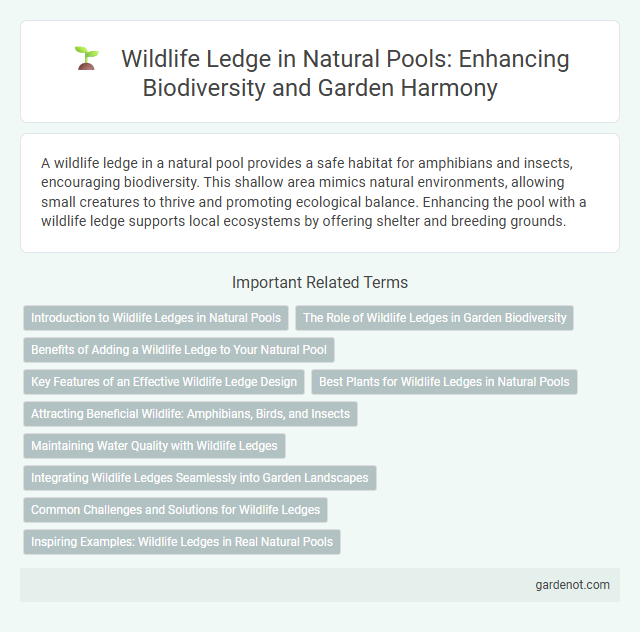A wildlife ledge in a natural pool provides a safe habitat for amphibians and insects, encouraging biodiversity. This shallow area mimics natural environments, allowing small creatures to thrive and promoting ecological balance. Enhancing the pool with a wildlife ledge supports local ecosystems by offering shelter and breeding grounds.
Introduction to Wildlife Ledges in Natural Pools
Wildlife ledges in natural pools provide essential shallow areas that support diverse aquatic plants and give refuge to small animals, promoting ecological balance. These ledges serve as critical habitats for amphibians, insects, and birds, fostering biodiversity in backyard ecosystems. Incorporating wildlife ledges enhances the natural filtration process and encourages a healthy, self-sustaining aquatic environment.
The Role of Wildlife Ledges in Garden Biodiversity
Wildlife ledges in natural pools provide essential habitats for amphibians, insects, and small aquatic creatures, enhancing garden biodiversity. These shallow, sheltered areas offer refuge, breeding grounds, and foraging sites, supporting diverse species and promoting ecological balance. Incorporating wildlife ledges into garden designs fosters a thriving ecosystem, increasing the natural pool's environmental value.
Benefits of Adding a Wildlife Ledge to Your Natural Pool
A wildlife ledge in a natural pool enhances biodiversity by providing a safe habitat for amphibians, insects, and small aquatic animals. It supports ecosystem balance, promoting natural pest control and improving water quality through biofiltration processes. This feature encourages wildlife observation and contributes to a sustainable, ecologically rich swimming environment.
Key Features of an Effective Wildlife Ledge Design
An effective wildlife ledge in a natural pool incorporates a gradual slope with varying depths to accommodate diverse species such as amphibians, reptiles, and aquatic insects. The use of native plants around the ledge enhances habitat complexity, providing shelter and breeding grounds while maintaining water quality. Durable, non-toxic materials and textured surfaces ensure safe access, supporting a thriving ecosystem within the pool environment.
Best Plants for Wildlife Ledges in Natural Pools
Optimal plants for wildlife ledges in natural pools include native aquatic species such as water lilies (Nymphaea spp.), pickerelweed (Pontederia cordata), and marsh marigold (Caltha palustris), which provide essential habitat for amphibians, insects, and birds. These plants contribute to water filtration, offering shelter and food sources while stabilizing the ledge's soil and preventing erosion. Incorporating diverse vegetation enhances biodiversity, supporting pollinators and improving the ecological balance within the natural pool ecosystem.
Attracting Beneficial Wildlife: Amphibians, Birds, and Insects
A wildlife ledge in a natural pool creates a shallow, accessible habitat that attracts amphibians such as frogs and newts, essential for controlling insect populations. Birds are drawn to the ledge for bathing and drinking, promoting biodiversity and natural pest management. Insects like dragonflies and pollinators benefit from the habitat, enhancing pollination and maintaining a balanced ecosystem within the natural pool environment.
Maintaining Water Quality with Wildlife Ledges
Wildlife ledges in natural pools enhance biodiversity by providing safe habitats for aquatic plants and animals while promoting natural filtration processes. These ledges support microorganisms and beneficial algae that break down pollutants, contributing to improved water clarity and balanced nutrient levels. Maintaining well-designed wildlife ledges reduces the need for chemical treatments, fostering a healthier and more sustainable natural pool ecosystem.
Integrating Wildlife Ledges Seamlessly into Garden Landscapes
Wildlife ledges provide critical habitats for amphibians and aquatic insects, enhancing biodiversity in natural pool environments. Integrating wildlife ledges into garden landscapes requires selecting materials that mimic natural rock formations and ensuring ledges have gradual slopes to support species movement. Strategic placement near aquatic vegetation and shallow water zones facilitates shelter, breeding, and foraging opportunities for diverse wildlife species.
Common Challenges and Solutions for Wildlife Ledges
Wildlife ledges in natural pools often face challenges such as limited shelter, fluctuating water levels, and predation risks. Effective solutions include installing stable, durable ledge materials that mimic natural habitats, incorporating varied vegetation to provide shelter, and designing water flow controls to maintain consistent water levels. Regular monitoring and adaptive management ensure these ledges remain safe and supportive environments for amphibians, insects, and other aquatic wildlife.
Inspiring Examples: Wildlife Ledges in Real Natural Pools
Wildlife ledges in natural pools create essential habitats for amphibians, insects, and small aquatic organisms, enhancing biodiversity and ecological balance. These shallow, gently sloping areas provide safe resting and breeding grounds while supporting native plant growth that stabilizes water quality. Notable examples include the Living Machine project in California and the Eden Project in the UK, where wildlife ledges demonstrate successful integration of natural ecosystems within recreational water features.
Wildlife ledge Infographic

 gardenot.com
gardenot.com